How to end virus lockdowns? Technology, tests, coordination
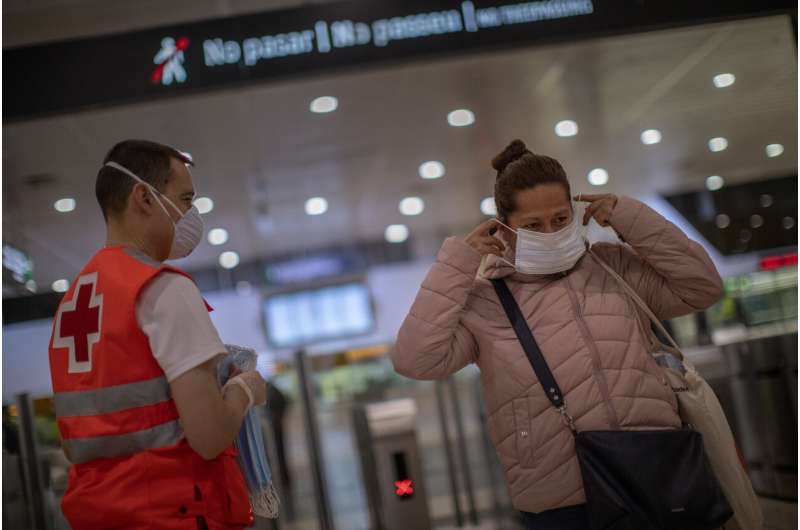
Governments battling a virus that has crossed borders with breathtaking swiftness pinned their hopes Tuesday on tests, technology and a coordinated approach to ease the tight social-distancing restrictions that have slowed the pandemic but strangled the global economy.
While the European Union looked into creating a COVID-19 smartphone app that could function across the bloc, governors on both U.S. coasts pledged to work together as they planned an end to the confinement of millions. The main concern is to avoid new coronavirus hot spots and flare-ups of infections. But trying to build such infrastructure while still in mid-crisis during the pandemic is proving difficult.
In India, the government on Tuesday extended the world's largest lockdown on 1.3 billion people for two more weeks, until May 3 for most of the country, as its caseload crossed 10,000.
China faced a new flare-up along its remote northern border with Russia, far from the original epicenter of Wuhan, which has all but declared victory in its battle against the pandemic. That vast border has been sealed and emergency medical units have rushed to the area to prevent travelers from bringing the virus back from overseas.
New infections appear to have leveled off in much of Asia and Europe, including Italy, France, Spain and Germany, said Dr. Sebastian Johnston, a professor of respiratory medicine at Imperial College London.
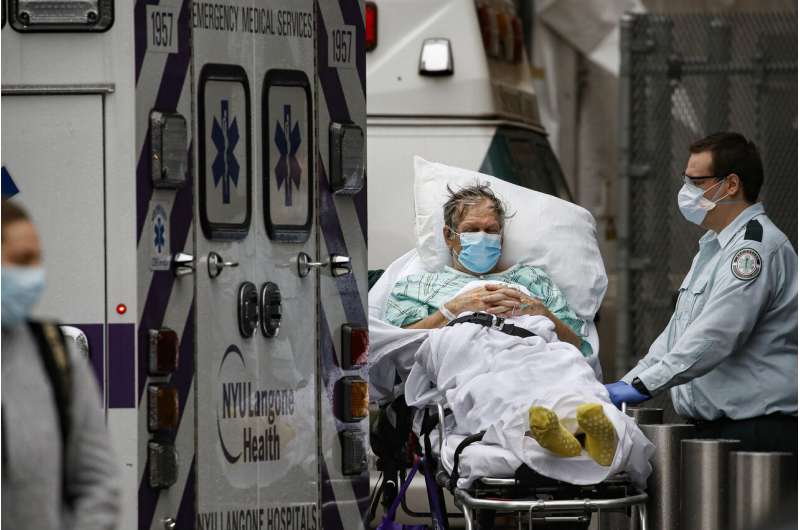
Even in New York—where reported coronavirus deaths passed 10,000 on Monday—Gov. Andrew Cuomo declared the "worst is over if we can continue to be smart." More than 23,000 people have died of the virus in the United States overall, with 582,000 confirmed infections, according to a tally by Johns Hopkins University.
With social distancing and lockdowns in place across a large portion of the world, grim projections that the virus that would spread with equal ferocity to other corners have yet to materialize. But without widespread antibody tests to determine how many people are immune to the virus, governments fear that relaxing social distancing could lead to new outbreaks.
Germany's foreign minister, Heiko Maas, called Tuesday for a single smartphone app to be used across the 27-nation EU to help countries coordinate when and how to relax their pandemic lockdown measures.
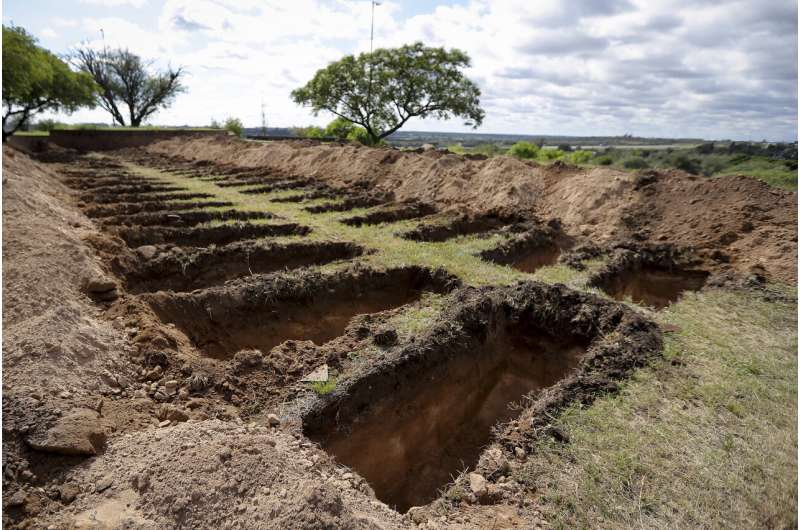
"It's important we don't end up with a patchwork of 27 corona apps and 27 data protection regimes, but coordinate as best as possible," he told Germany's Funke media group.
Maas said a contract tracing app already being jointly developed by several countries showed that the EU "doesn't have to copy the Big Brother methods of authoritarian states" but can instead safeguard personal privacy and public health at the same time.
The head of the Robert Koch Institute, Germany's disease control center, said exchanging information between countries and institutions is key to combating the pandemic. Lothar Wieler said Tuesday his group is in constant contact with others to share which measures are effective in preventing the virus from spreading, how to test for infection, which vaccine studies to fund and how best to protect vulnerable populations.
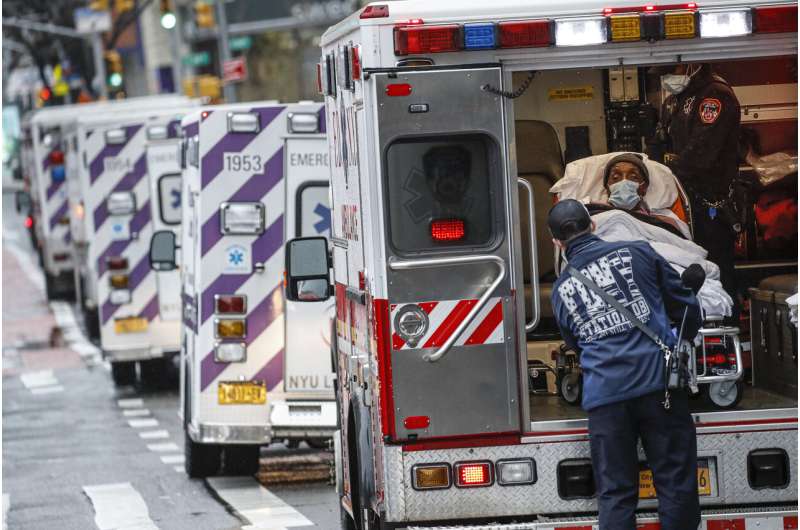
Apple and Google last week announced a separate joint effort to help public health agencies worldwide leverage smartphones by using Bluetooth wireless technology to trace the contacts of those infected so as to slow the spread of the virus. That will run on iPhones and Android phones alike. The apps would gather a record of other phones when they came into close proximity.
In China, where new reported virus cases have dwindled, life is ruled by a green symbol on a smartphone screen that says a user is symptom-free and can board a subway, check into a hotel or just enter Wuhan, the city of 11 million people where the pandemic began in December.
South Korea and Israel have both aggressively used smartphone data to track the movements of virus carriers. But in general, epidemiologists say contact tracing can only be effective with widely available testing, which has been difficult even in wealthy countries such as the United States and Britain.
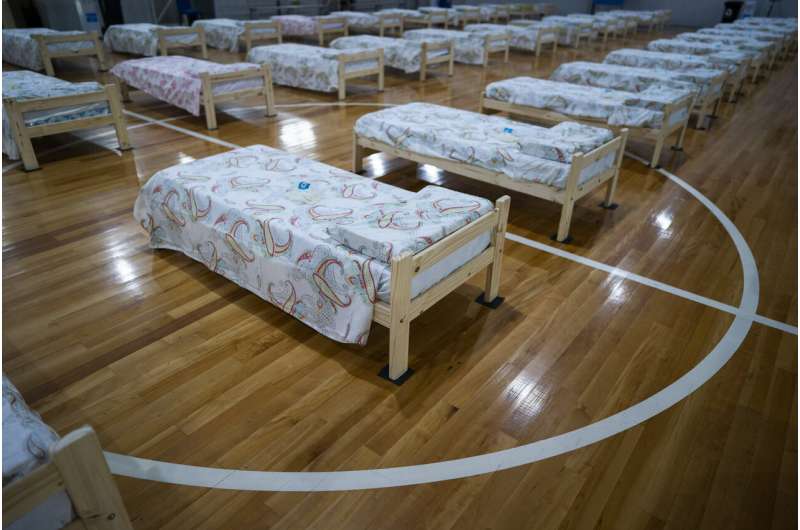
Experts say the infection rate still remains relatively low in areas of the developing world that have poor or nonexistent health care infrastructure and far fewer resources to trace the contacts of coronavirus patients.
The rapid spread of the coronavirus beyond cities to more rural areas often depends on travel and social connections, said Dr. Mike Ryan, the World Health Organization's emergencies chief. That could explain why Germany and Switzerland, with their world-class train systems, have over 155,000 infections between them.
But he noted that rural areas often have less sophisticated health surveillance systems to pick up potential disease clusters,,
"Is it that it's not there, or is it that we're not detecting the disease when it is there?" he asked.
Johnston, the Imperial College professor, said he worried the virus might take off across Latin America, Africa and Southeast Asia. He also expressed concern about Russia.
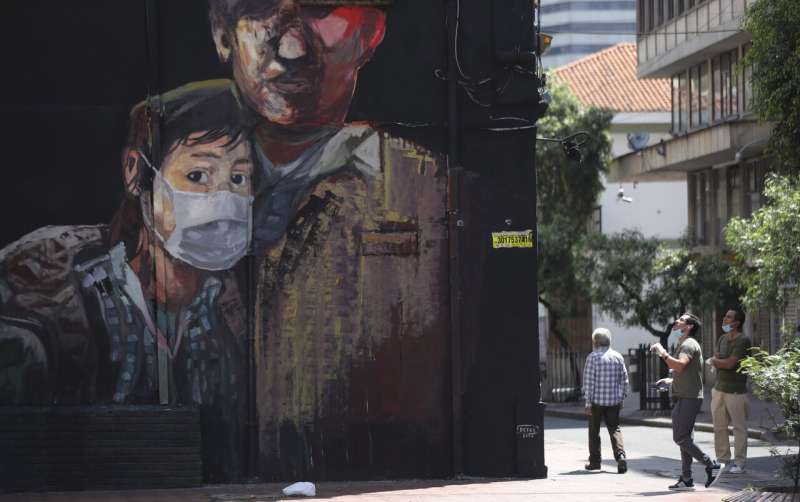
Despite the absence of a coordinated exit strategy, in some European countries, officials pointed to positive signs as they began prepping to reopen largely shuttered economies and industries.
Italy's day-to-day increase in infections was one of the lowest in weeks, bolstering a generally downward trend. Slightly eased restrictions were about to take effect in some sectors of the country, such as allowing stores selling baby necessities to reopen.
In hard-hit Spain, workers returned Monday to some factory and construction jobs. Retail stores and services were still closed and the government required office workers to keep working from home.
In the United States, governors in the Northeast and along the West Coast announced separate state compacts to coordinate reopenings.
California Gov. Gavin Newsom said he would announce a detailed plan Tuesday for lifting virus restrictions. He cautioned it would use "science to guide our decision-making and not political pressure."
-

A man leans out the window on Mulberry Street in New York's Little Italy and bangs together pot lids to show his support for those in the front lines fighting against the coronavirus pandemic, Monday, April 13, 2020. Citywide people open their windows each evening at 7 p.m. to make noise to support the doctors, nurses, hospital staff, EMT's and front-line workers who are risking their lives every day. (AP Photo/Mark Lennihan) -
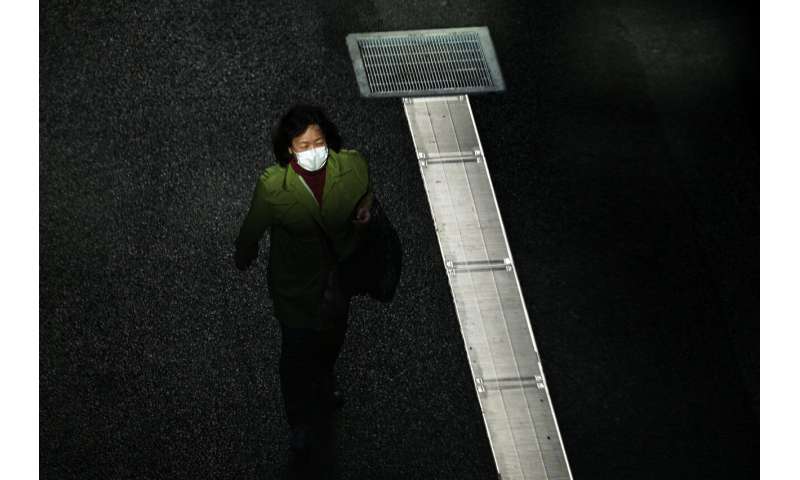
A woman wearing a protective mask walks at Shibuya Tuesday, April 14, 2020, in Tokyo. Japanese Prime Minister Shinzo Abe declared a state of emergency last week for Tokyo and some other prefectures to ramp up defenses against the spread of the coronavirus. (AP Photo/Eugene Hoshiko) -
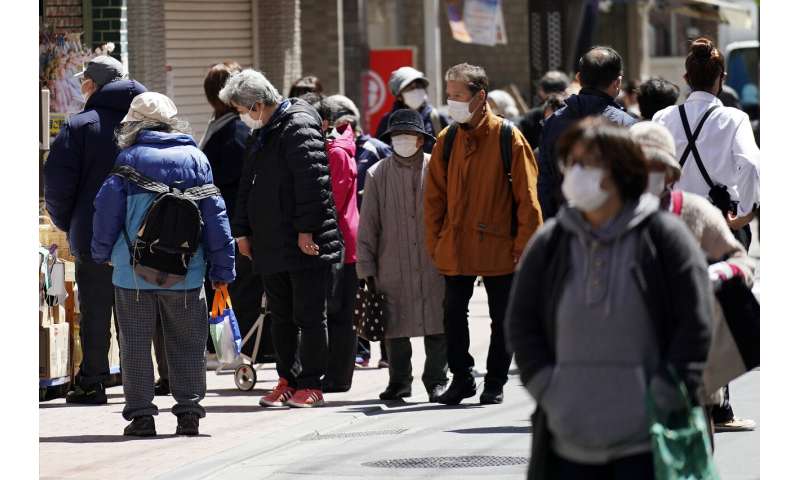
People wearing protective masks stroll a shopping street Tuesday, April 14, 2020, in Tokyo. Japanese Prime Minister Shinzo Abe declared a state of emergency last week for Tokyo and some other prefectures to ramp up defenses against the spread of the coronavirus. (AP Photo/Eugene Hoshiko) -
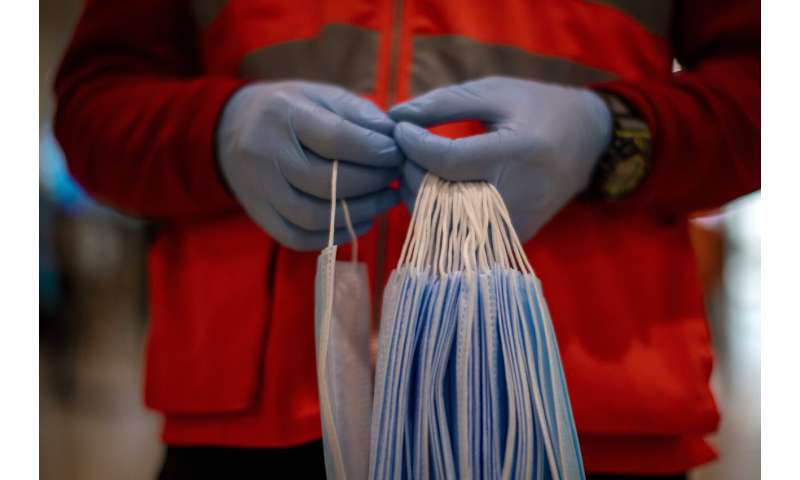
A red cross volunteer holds face mask to be distributed to passengers arriving at the main train station in Barcelona, Spain, Tuesday, April 14, 2020. Face mask distribution in train and bus stations continue as factory and construction workers resume their activities in roughly half of Spanish regions emerging from the Easter holiday period. Spain's left-wing Cabinet is expected to pass new measures to aide smaller business and the self-employed affected by the freezing of economic activity. (AP Photo/Emilio Morenatti) -
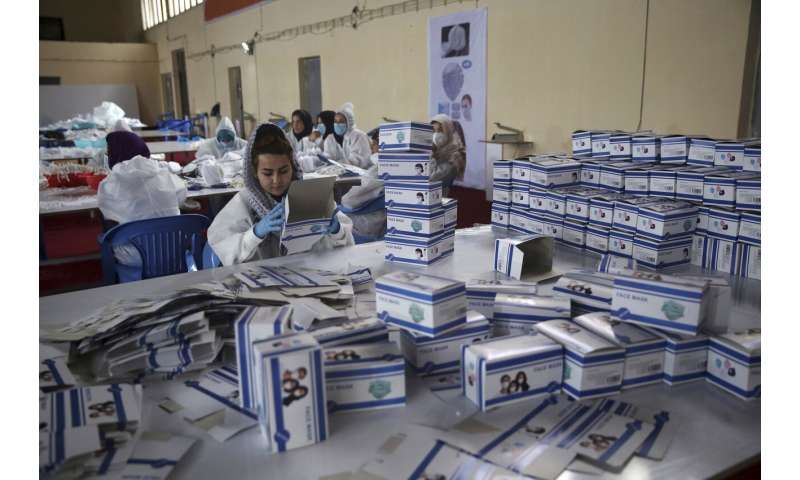
Face masks used to curb the spread of the coronavirus are assembled at a factory in Kabul, Afghanistan, Tuesday, April 14, 2020. The new coronavirus causes mild or moderate symptoms for most people, but for some, especially older adults and people with existing health problems, it can cause more severe illness or death. (AP Photo/Rahmat Gul) -
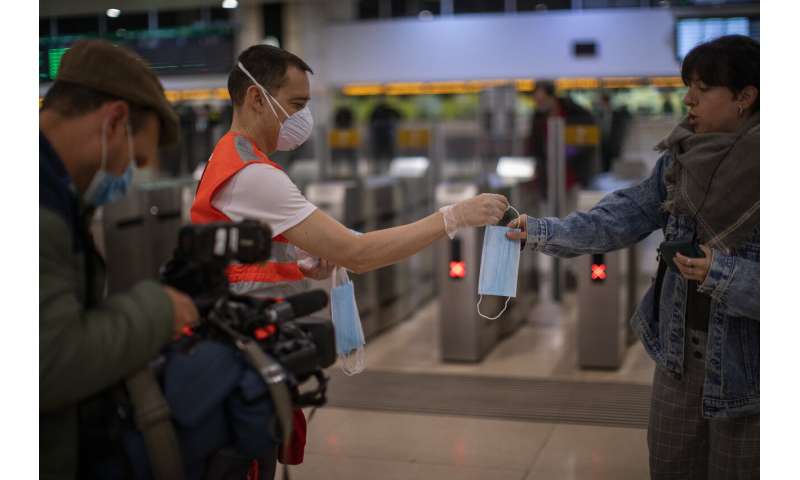
A passenger receives a face mask distributed by a red cross volunteer at the main train station in Barcelona, Spain, Tuesday, April 14, 2020. Face mask distribution in train and bus stations continue as factory and construction workers resume their activities in roughly half of Spanish regions emerging from the Easter holiday period. Spain's left-wing Cabinet is expected to pass new measures to aide smaller business and the self-employed affected by the freezing of economic activity. (AP Photo/Emilio Morenatti) -
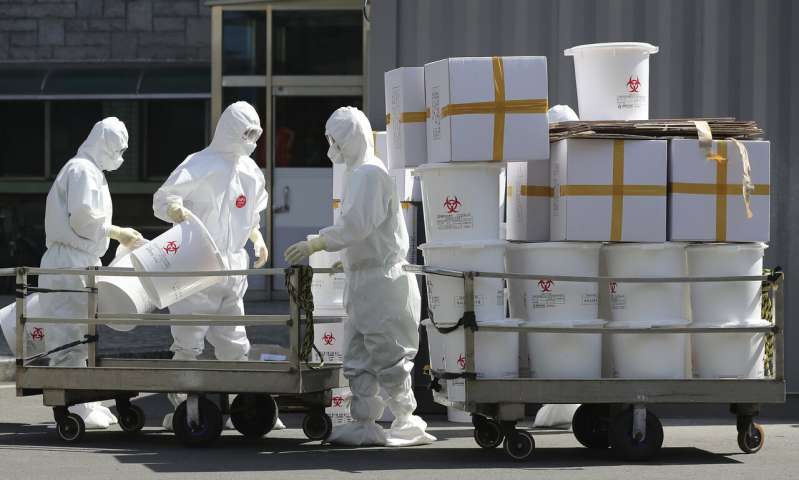
Medical staff members in protective gears stack plastic buckets containing medical waste at Dongsan Medical Center in Daegu, South Korea, Tuesday, April 14, 2020. The new coronavirus causes mild or moderate symptoms for most people, but for some, especially older adults and people with existing health problems, it can cause more severe illness or death. (Kim Do-hun/Yonhap via AP) -
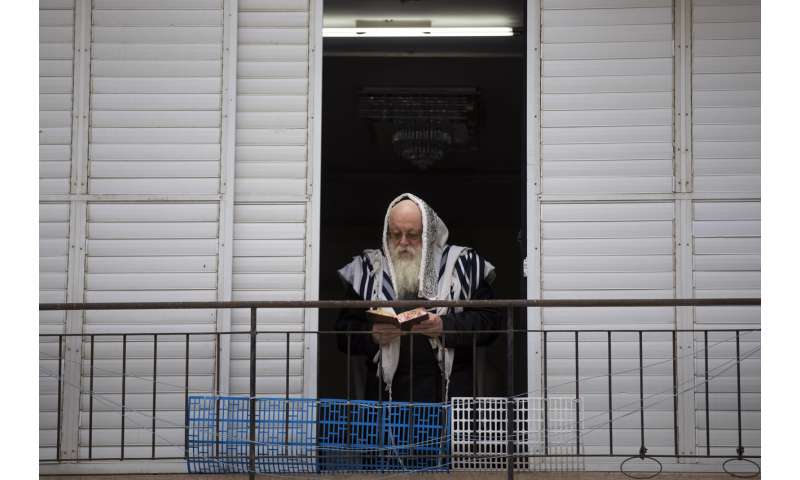
An Ultra-Orthodox Jew prays a morning prayer at his house as synagogues are closed following the government's measures to help stop the spread of the coronavirus, in Bnei Brak, Israel, Tuesday, April 14, 2020. Israeli Prime Minister Benjamin Netanyahu announced Monday a complete lockdown till the end of Passover holiday to control the country's coronavirus outbreak. (AP Photo/Oded Balilty) -
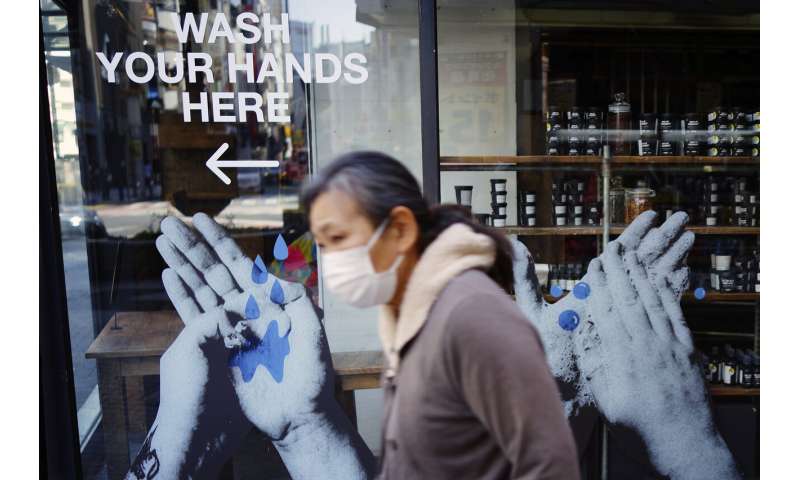
A woman wearing a face mask walks near a shop featuring a washing hands slogan Tuesday, April 14, 2020, in Tokyo. Japanese Prime Minister Shinzo Abe declared a state of emergency last week for Tokyo and some other prefectures to ramp up defenses against the spread of the coronavirus. (AP Photo/Eugene Hoshiko) -
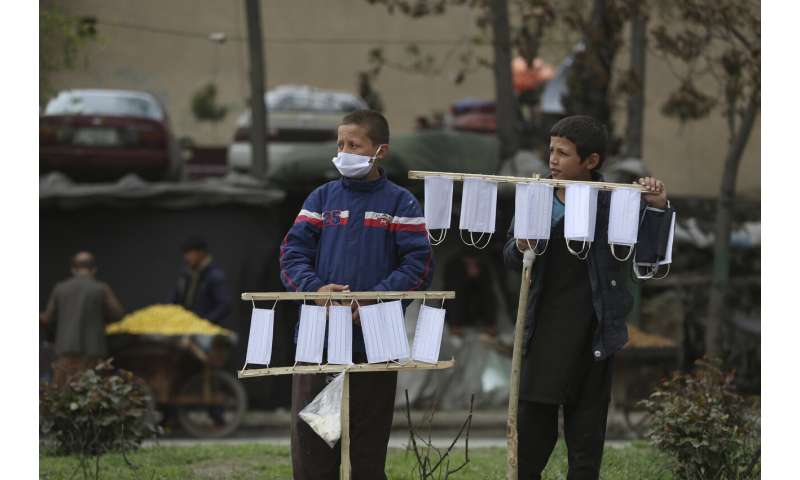
Street vendors selling protective masks to help curb the spread of the coronavirus wait for customers in Kabul, Afghanistan, Tuesday, April 14, 2020. (AP Photo/Rahmat Gul) -
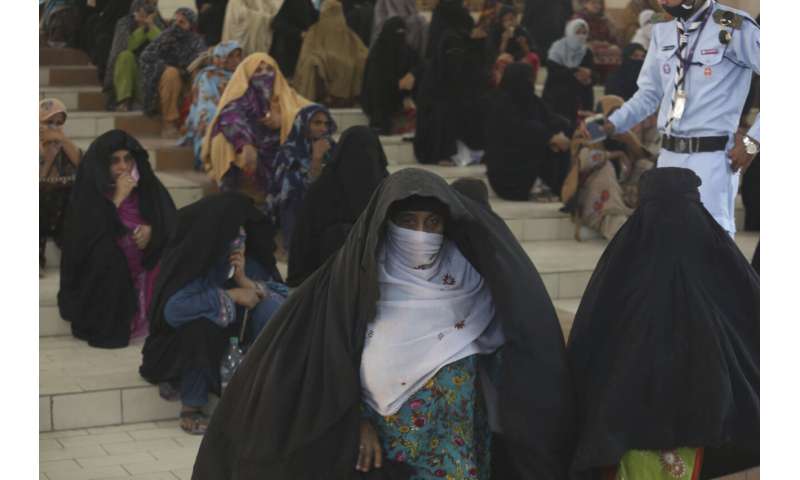
People wait to receive cash under the government's Ehsaas Emergency Cash Program for families in need, during a government-imposed nationwide lockdown to help contain the spread of the coronavirus, in Karachi, Pakistan, Tuesday, April 14, 2020. Pakistan plans to distribute financial assistance among 10.2 million low-income families across the country impacted by the virus. (AP Photo/Fareed Khan)
"The house is still on fire," New Jersey Gov. Phil Murphy said. "We still have to put the fire out ... (but we need) to make sure this doesn't reignite."
His state is in a coalition with Connecticut, Delaware, Massachusetts, New York, Pennsylvania and Rhode Island while the governors of California, Oregon and Washington announced a similar plan.
President Donald Trump pushed back against the governors, claiming "the federal government has absolute power" over easing the restrictions if it chooses. The Constitution, however, largely gives states the authority to regulate their own affairs.
More than 1.9 million infections have been reported and over 119,000 people have died worldwide, according to Johns Hopkins University. The figures understates the true size of the pandemic, due to limited testing, uneven counting of the dead and unreliable figures from some governments.
© 2020 The Associated Press. All rights reserved. This material may not be published, broadcast, rewritten or redistributed without permission.



















